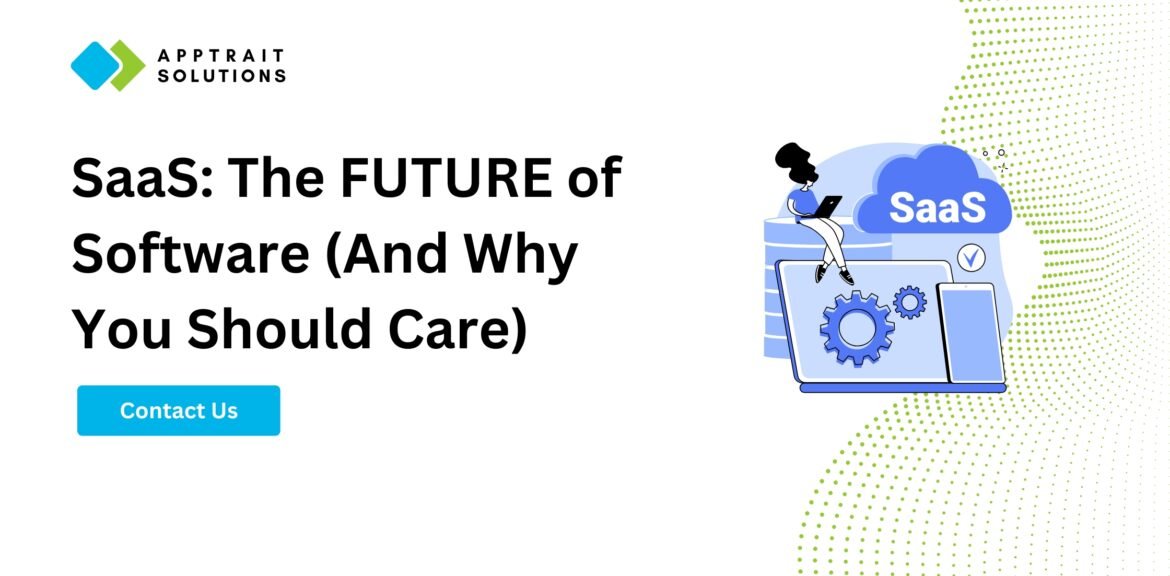Cloud computing has revolutionized business operations, with Software as a Service (SaaS) driving this shift. It offers flexible, maintenance-free solutions, giving companies access to powerful tools on demand.
Explore SaaS, its benefits, and why it matters—plus, don’t miss our SaaS product development checklist by Apptrait Solutions to build a winning solution!
Introduction: The Rise of the Cloud and On-Demand Software
The Shifting Software Landscape: From On-Premise to Cloud-Based Solutions
In the past, companies relied on on-premise software, requiring significant investments in hardware and maintenance. Today, SaaS provides an alternative that eliminates many of these burdens. With SaaS, everything runs from the cloud, allowing users to access software from anywhere, at any time.
Defining SaaS: A Simple Explanation
SaaS stands for Software as a Service. This means that software is delivered over the Internet, eliminating the need for installation on individual computers. Users subscribe to software hosted on cloud servers, which can be accessed via a web browser.
Why SaaS Matters: Benefits for Businesses of All Sizes
SaaS solutions offer critical advantages. They enable quick deployment, reduce costs, and continually update software. Such benefits make it an attractive option for startups and large enterprises alike.
Understanding the SaaS Model: How it Works
The Subscription Model: Recurring Revenue and Scalability
Most SaaS applications function on a subscription basis. Users pay monthly or annually for access. This model not only simplifies budgeting but also supports scalability as businesses grow or downsize.
Access and Deployment: Cloud-Based Accessibility and Easy Implementation
SaaS applications are hosted in the cloud, allowing users to access them from any device with internet connectivity. This ease of deployment means businesses can implement software quickly without extensive setup.
Data Storage and Security: Cloud Provider Responsibilities and User Security
Security is crucial in the SaaS model. Cloud providers manage the servers, ensuring data is backed up and secure. Users need to understand their responsibilities, such as creating strong passwords and managing access rights.
Key Benefits of Choosing SaaS Solutions
Cost-Effectiveness: Reduced Infrastructure and IT Costs
- Lower upfront investment: Companies avoid the high costs of purchasing software licenses and hardware.
- Predictable monthly expenses: Subscriptions provide clarity in budgeting.
Scalability and Flexibility: Adapting to Changing Business Needs
- Easy scaling up or down based on demand: Companies can adjust the number of licenses as needed.
- Quick implementation and deployment: Businesses can start using software almost immediately.
Enhanced Collaboration and Productivity: Real-time Access and Shared Workspaces
- Improved team communication: Teams can easily collaborate through shared platforms.
- Increased efficiency and productivity: Cloud-based solutions enable real-time updates and access to resources.
Different Types of SaaS Applications
Customer Relationship Management (CRM) Software: Salesforce, HubSpot
CRM tools help manage customer interactions, streamlining sales processes.
Enterprise Resource Planning (ERP) Software: SAP, Oracle NetSuite
ERP systems integrate various business functions, enhancing operational efficiency.
Marketing Automation Software: Marketo, Pardot
These tools automate marketing campaigns, allowing for more precise targeting and tracking.
Project Management Software: Asana, Trello, Monday.com
Project management apps help teams organize tasks efficiently, keeping projects on track.
Choosing the Right SaaS Solution for Your Business
Identifying Your Business Needs and Requirements
Start by assessing what problems you want to solve. Determine which features are essential.
Evaluating Key Features and Functionality
Look for software that meets your requirements. The right tools should provide the functionalities that align with your goals.
Comparing Pricing Models and Vendor Offerings
Not all SaaS applications are created equal. Compare features, pricing, and terms before making a decision.
Conducting Thorough Due Diligence and Vendor Research
Research potential vendors to ensure they have a good track record. Check reviews and testimonials.
SaaS: The Future of Software
Growing Market Share and Adoption Rates
SaaS continues to grow, with over 60% of organizations using cloud services as of 2023. This trend shows no signs of slowing.
Emerging Trends and Innovations in SaaS Technology
New AI and machine learning features are increasingly being integrated into SaaS solutions, making them smarter and more responsive.
The Long-Term Impact of SaaS on Business Operations
Expert Mark Zohar states, “SaaS is reshaping how businesses operate by enabling faster decision-making and improving collaboration.” This shift will likely drive continued innovation in all sectors.
Conclusion: Embracing the Power of SaaS
SaaS simplifies business operations, reduces costs, and enhances collaboration. The flexibility it offers makes it suitable for a range of business needs.
Dive into the world of SaaS today with apptraitsolutions.com. Explore different solutions that can elevate your business, streamline operations, and drive success. Start realizing the benefits this powerful model offers.



